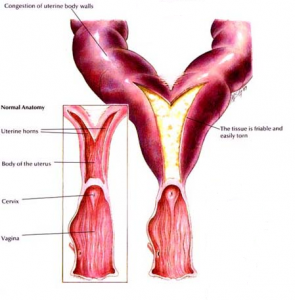Pyometra Surgery
Pyometra Surgery
Pyometra is a serious infection of the uterus in dogs that can result in death if not treated immediately. It can occur in young females, but is most frequently observed in older intact dogs. If an unspayed female has been through a number of consecutive heat cycles without producing any litter, the lining of her uterus will gradually grow thicker, resulting in the formation of a cyst. This creates the perfect breeding grounds for bacteria, which build up over time and cause an infection. Another theory is that the increased glandular secretions exacerbate and infection. Pyometra occurs several weeks after a heat cycle, and the quickest and safest solution in these cases is surgical removal of the infected tissue
Common signs of pyometra
The cervix can either be open or closed when the infection forms. If it is open a certain amount of discharge (bloody, purulent, or mucoid discharge) will drain, and will appear beneath the tail and on surfaces that the dog comes in contact with. If the cervix stays closed, the infection won’t be able to drain and the dog’s condition will deteriorate quite rapidly. Other symptoms may include:
● Strong fevers
● Weak appetite and weight loss
● Depression
● Vomiting and diarrhoea
● Noticeably bloated stomach
● Dehydration
● Excessive urination
● Vulvar DischargeIt is very important to pick up on these symptoms early on and get the dog to a vet as soon as possible, to avoid any further complications and ensure a relatively speedy recovery.
Surgical procedure
Before the operation the dog is stabilized by administering antibiotics and fluids, and tests are done to assess the severity of the problem. The dog then given general anaesthesia and is intubated in preparation for surgery. All the vital signs are carefully monitored to ensure that the procedure goes smoothly, and a single lengthwise incision is made along the belly. The organs are more closely inspected to determine the extent of the damage.
The infected organs are very carefully brought out and placed on sterile pads. In certain cases the uterus may burst open prior to surgery, but even if this doesn’t happen there is a risk of either the uterus or the blood vessels rupturing during the operation, as they become stretched out and incredibly fragile as the infection piles up. Due to this increased risk, a blood transfusion may also be needed.
The ovaries and uterus are then removed and everything cleaned out thoroughly. After removing the uterus/ovaries, the rest of the organs are carefully placed back inside, the inner layers are sutured, and the skin of the belly is closed up using either stitches or staples that will later be removed.
Postoperative care and recovery
Following the surgery the dog will be placed under close surveillance for up to 48 hours, to ensure that there her condition does not deteriorate, and that any complications that may occur are quickly resolved. Our highly trained staff handles each patient with the utmost care and devotion in order to ensure a fast recovery. After the dog is sent home, she will receive antibiotics during the next couple of weeks, after which she will need to be brought in for a check-up, where we will remove the stitches and advise the owner on additional care. It is important to keep the dog calm and quiet, so that she doesn’t break the stitches.








